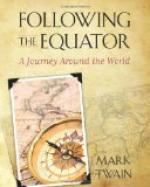When we arrived at the bungalow, the large hall on the ground floor was already about full, and carriages were still flowing into the grounds. The company present made a fine show, an exhibition of human fireworks, so to speak, in the matters of costume and comminglings of brilliant color. The variety of form noticeable in the display of turbans was remarkable. We were told that the explanation of this was, that this Jain delegation was drawn from many parts of India, and that each man wore the turban that was in vogue in his own region. This diversity of turbans made a beautiful effect.
I could have wished to start a rival exhibition there, of Christian hats and clothes. I would have cleared one side of the room of its Indian splendors and repacked the space with Christians drawn from America, England, and the Colonies, dressed in the hats and habits of now, and of twenty and forty and fifty years ago. It would have been a hideous exhibition, a thoroughly devilish spectacle. Then there would have been the added disadvantage of the white complexion. It is not an unbearably unpleasant complexion when it keeps to itself, but when it comes into competition with masses of brown and black the fact is betrayed that it is endurable only because we are used to it. Nearly all black and brown skins are beautiful, but a beautiful white skin is rare. How rare, one may learn by walking down a street in Paris, New York, or London on a week-day particularly an unfashionable street—and keeping count of the satisfactory complexions encountered in the course of a mile. Where dark complexions are massed, they make the whites look bleached-out, unwholesome, and sometimes frankly ghastly. I could notice this as a boy, down South in the slavery days before the war. The splendid black satin skin of the South African Zulus of Durban seemed to me to come very close to perfection. I can see those Zulus yet—’ricksha athletes waiting in front of the hotel for custom; handsome and intensely black creatures, moderately clothed in loose summer stuffs whose snowy whiteness made the black all the blacker by contrast. Keeping that group in my mind, I can compare those complexions with the white ones which are streaming past this London window now:
A lady. Complexion,
new parchment. Another lady. Complexion,
old
parchment.
Another. Pink and white, very fine.
Man. Grayish skin, with purple areas.
Man. Unwholesome fish-belly skin.
Girl. Sallow face, sprinkled with freckles.
Old woman. Face whitey-gray.
Young butcher. Face a general red flush.
Jaundiced man—mustard yellow.
Elderly lady. Colorless skin, with two conspicuous moles.
Elderly man—a
drinker. Boiled-cauliflower nose in a flabby
face
veined with purple crinklings.




